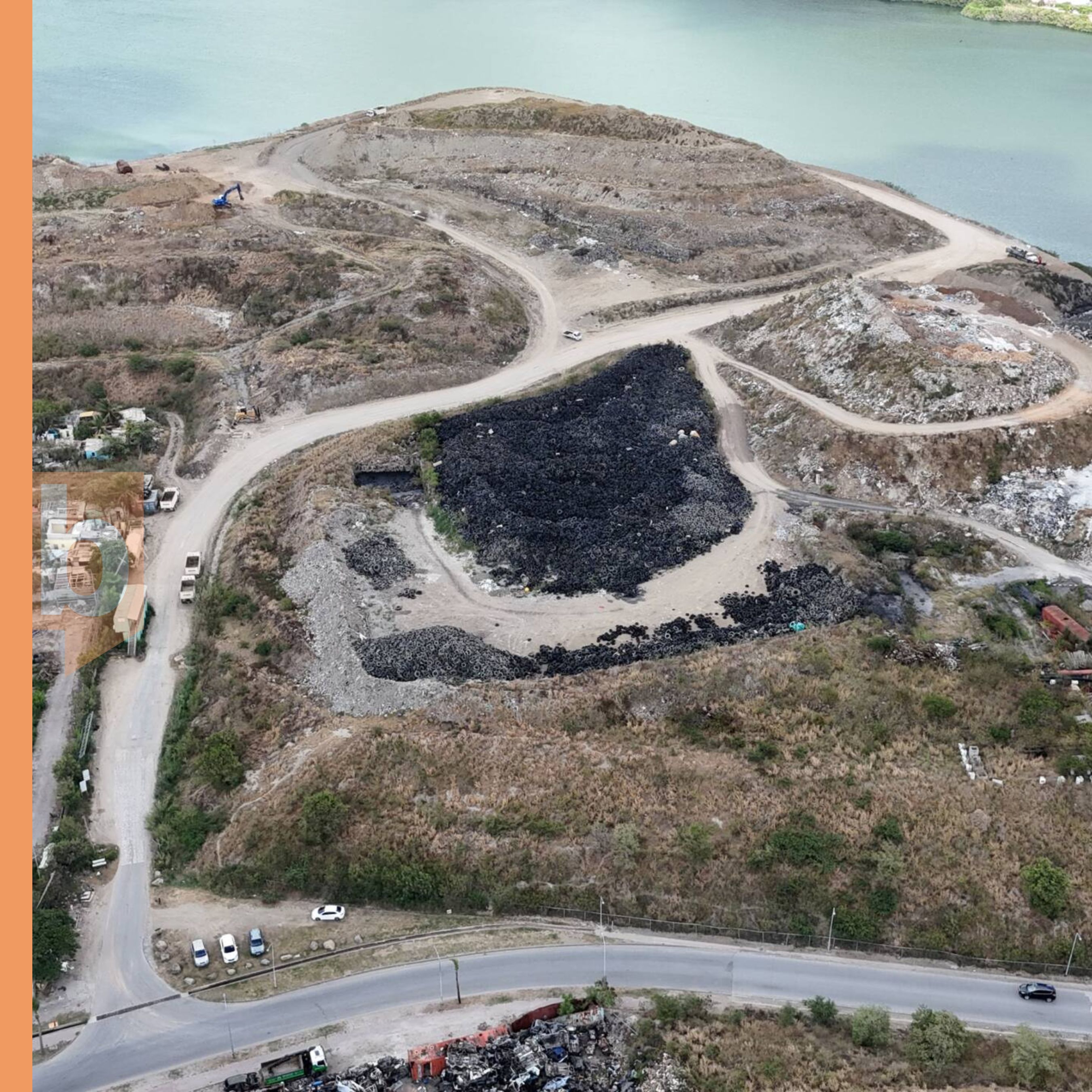Putting Out the Fire for Good: St. Maarten’s Landfill Faces Its Future

GREAT BAY--For decades, the landfill at Pond Island has loomed over St. Maarten as both a symbol of survival and a threat to health and environment. Known informally as “the dump,” it is where household garbage, construction debris, and hurricane wreckage all converge, with little separation or treatment. Fires have smoldered beneath its surface, foul odors have seeped across neighborhoods, and contaminated runoff has flowed into the Great Salt Pond and eventually Great Bay.
Now, a detailed Environmental and Social Management Plan (ESMP) lays out a blueprint for finally tackling the problem. The plan calls for slope recontouring and closure of the landfill, the stabilization of debris dumped after Hurricane Irma, and the construction of auxiliary facilities to bring waste handling up to safer standards.
The challenges are immense. But so are the stakes.
𝐀 𝐅𝐫𝐚𝐠𝐢𝐥𝐞 𝐁𝐚𝐬𝐞𝐥𝐢𝐧𝐞
St. Maarten is the most densely populated country in the Caribbean, with more than 40,000 people packed into 34 square kilometers. All of its waste funnels into the Municipal Solid Waste Disposal Sites (MSWDS) on Pond Island, covering more than 200,000 square meters in total.
Unlike larger countries with transfer stations or recycling facilities, the island has relied on a direct disposal model: garbage goes straight from trucks to the heap. Construction debris, ash, tires, and green waste pile together with household trash. Fires sometimes ignite spontaneously deep below the surface.
The environmental toll has been clear. The ESMP confirms:
• Leachate and sewage flow directly into the Great Salt Pond, which drains into Great Bay. Tests show elevated bacteria, nitrogen, phosphorus, and heavy metals.
• Air quality is compromised by smoke from underground fires, and noise pollution comes from crushers and recycling operations running as high as 120 dB.
• Biodiversity is fragile, with invasive tilapia dominating the pond, and mangroves clinging to the waterfront. The pond still supports over 170 bird species, but its water quality is poor.
• On top of that, nearby residents and businesses, including the University of St. Martin, have long borne the brunt of dust, traffic, and odor.
𝐓𝐡𝐞 𝐈𝐧𝐭𝐞𝐫𝐯𝐞𝐧𝐭𝐢𝐨𝐧 𝐏𝐥𝐚𝐧
The ESMP outlines a series of interventions that will reshape the landfill into a safer, more stable site:
1. Recontouring and Closure
Bulldozers and excavators will reshape slopes, cover waste with new materials, and install liners, drainage mats, and gas control systems. The goal is to reduce fires, stabilize the heap, and cut down on greenhouse gas emissions.
2. Irma Debris Site Closure
The massive volume of construction and hurricane waste dumped after 2017 will be leveled and capped. This involves removing and reinstating mangroves along the water’s edge and controlling water turbidity to protect aquatic life.
3. Auxiliary Buildings and Infrastructure
New service roads, fencing, wastewater handling facilities, and a waste processing yard will modernize daily operations. This includes crushers and shredders that can turn waste into recycled aggregate.
𝐁𝐚𝐥𝐚𝐧𝐜𝐢𝐧𝐠 𝐁𝐞𝐧𝐞𝐟𝐢𝐭𝐬 𝐚𝐧𝐝 𝐑𝐢𝐬𝐤𝐬
Each intervention carries trade-offs. The ESMP spells them out bluntly:
• Environmental Negatives: Dust, noise, emissions from machinery, oil leaks, and temporary destruction of mangroves.
• Environmental Positives: Less leachate, fewer fires, improved slope stability, reduced greenhouse gases, and ultimately a cleaner pondfront once vegetation is restored.
• Social Negatives: Businesses operating on the landfill land will be displaced, road traffic will intensify, and foreign labor could increase risks of exploitation or harassment.
• Social Positives: Better waste management, safer working conditions, new job opportunities, and more attractive surroundings.
One of the most sensitive issues is the displacement of existing tenants. Steel Crushers B.V., Windward Roads N.V., and the Sint Maarten Soccer Association all hold leases on parts of the landfill site. The plan proposes relocation, compensation, and in some cases provision of alternative facilities, but those negotiations remain delicate.
𝐌𝐢𝐭𝐢𝐠𝐚𝐭𝐢𝐨𝐧 𝐌𝐞𝐚𝐬𝐮𝐫𝐞𝐬
To manage the risks, the ESMP proposes a long list of safeguards:
• Dust suppression with water sprays and vapor cannons.
• Traffic control along Soualiga Road, including restricted hours for trucks and monthly repairs to damage.
• Noise barriers around crushers and recycling facilities.
• Mangrove replanting after construction to restore coastal buffers.
• Fire suppression strategies with coordination from the Fire Department.
• Safety gear and training for workers exposed to dust, gases, or heavy machinery.
• Public communications plan to keep residents informed of construction phases.
The plan also stresses the importance of monitoring, from air quality and groundwater sampling to ecological surveys and noise checks, so impacts can be corrected quickly.
𝐏𝐮𝐛𝐥𝐢𝐜 𝐂𝐨𝐧𝐬𝐮𝐥𝐭𝐚𝐭𝐢𝐨𝐧: 𝐍𝐞𝐱𝐭 𝐒𝐭𝐞𝐩𝐬 𝐢𝐧 𝐖𝐚𝐬𝐭𝐞 𝐌𝐚𝐧𝐚𝐠𝐞𝐦𝐞𝐧𝐭
The Government of Sint Maarten and the National Recovery Program Bureau (NRPB) have scheduled a Public Consultation on Wednesday, September 3, 2025, at the Belair Community Center to present the future of waste management on the island.
During the session, the Government will outline its priorities, policy direction, and strategic vision for addressing the landfill and broader waste challenges. The NRPB, which is executing the Emergency Debris Management Project (EDMP), will provide an overview of current and upcoming activities.
Finally, consultants Witteveen + Bos, in collaboration with TAUW, will present technical details of the landfill feasibility study and draft designs. They will also walk the public through the Environmental and Social Impact Assessment (ESIA) and the Environmental and Social Management Plan (ESMP), ensuring community members can understand both the risks and the solutions being proposed.
𝐀 𝐍𝐚𝐭𝐢𝐨𝐧𝐚𝐥 𝐓𝐮𝐫𝐧𝐢𝐧𝐠 𝐏𝐨𝐢𝐧𝐭
The landfill has long been both a necessity and a hazard for St. Maarten. Efforts to close or replace it have stumbled in the past, leaving the public skeptical. But the ESMP signals a more structured, science-driven approach, backed by international standards.
Poor waste management threatens tourism, public health, and the environment. A reengineered and stabilized landfill offers the chance to reduce fire outbreaks, cut pollution into the Great Salt Pond, and restore some dignity to a site that has symbolized dysfunction for years.
Whether St. Maarten can deliver on this plan depends not only on contractors and bulldozers, but also on political will, transparency, and community buy-in. For residents who live with the smell, the smoke, and the sight of the landfill every day, the message is simple: this cannot be another report that gathers dust.
The landfill is already burning from within. The time now is to put the fire out for good.
Join Our Community Today
Subscribe to our mailing list to be the first to receive
breaking news, updates, and more.





%20(412%20x%20570%20px)%20(412%20x%20340%20px).jpg)